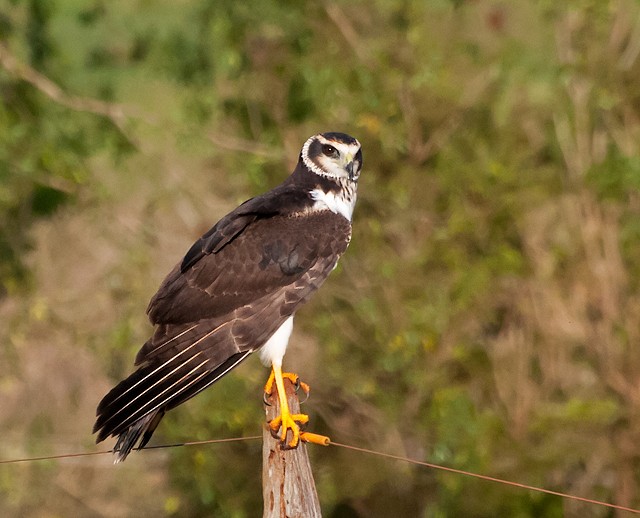Long-winged Harrier
A species of Harriers Scientific name : Circus buffoni Genus : Harriers
Long-winged Harrier, A species of Harriers
Botanical name: Circus buffoni
Genus: Harriers
Content
Description General Info
 Photo By https://www.flickr.com/photos/dariosanches/ , used under CC-BY-SA-2.0 /Cropped and compressed from original
Photo By https://www.flickr.com/photos/dariosanches/ , used under CC-BY-SA-2.0 /Cropped and compressed from original Description
The long-winged is mid-sized bird of prey, and like most birds of prey species, the females are larger than the males. Males will weigh from 390 g to 464 g (13.8 oz to 16.4 oz) and females will be slightly heavier, ranging from 400 g to 645 g (14.1 oz to 22.8 oz). Their length can range between 46 cm and 60 cm (18.1 in to 23.6 in) and their wingspan ranges between 120 cm and 155 cm (47.2 in to 61.0 in). As other harrier species, the lon-winged harrier can be identified by its long and narrow tail and its especially long wings. Their wings and their back are mostly grey, with the primary feathers on the wings being much darker than the rest of the wing feathers, which are streaked with variants of white, grey and brown. The long-winged harrier can arbor 2 different morphs, a dark morph and a light morph. In dark morph individuals, the belly is all black with females having more of a brown undertone. The light morph individuals can be identified by their white underparts, which contrasts heavily with their dark morph counterpart. Juvenile long-winged harriers usually have the same colour patterns as females, but they have a more speckled chest. The long-winged harrier morphologically resembles its close relative, the cinereous harrier (Circus cinereus), which can also be found in South America, but their range rarely overlaps. As all other birds of prey species, the long-winged harrier possesses sharp talons used to catch their prey on the ground or in the air, and their legs are bright orange. The species also shares the large hooked beak of other birds of prey, which it uses to tear apart meat once it catches its prey. The long-winged harrier is part of the only diurnal bird of prey group to possess a facial disc. The facial disc is formed by a group of easily recognizable group of feathers that form a disc shape around the bird's face. These feathers can be raised in response to sounds and can improve the bird's hearing when it is hunting by triangulating sounds in its ear holes. 
Size
60 cm
Nest Placement
Ground
Feeding Habits
Long-winged Harrier primarily consumes small mammals, amphibians, reptiles, and other birds. It employs aerial and ground hunting techniques during various feeding times and exhibits unique dietary preferences that distinguish it from other raptors.
Habitat
The long-winged Harrier predominantly dwells in open landscapes such as large grasslands, savannas, marshes, and agricultural fields like wheat and rice paddies. These birds favor moderately wet areas and are usually found in the lowland tropical zone, thriving particularly in natural grasslands. Occasionally, long-winged Harrier can adapt to drier environments and may even be spotted near wooded territories, especially during the non-breeding season. While they typically inhabit regions below 690 meters, there have been sightings up to 2000 meters in Argentina and between 300 to 1000 meters in Colombia.
Dite type
Carnivorous
General Info
Feeding Habits
Bird food type
Distribution Area
The long-winged harrier's year-round range encompasses most of eastern South America, including eastern Argentina, Uruguay, Brazil and Paraguay, and extends up to Colombia, Venezuela, and the northern tips of Guyana, Suriname and French Guyana. The species has also been observed occasionally in extant areas such as Bolivia, Peru, Chile, Trinidad and Tobago, and all the way down to Tierra del Fuego in southern Argentina. It is vagrant to Panama and the Falkland Islands. This species occupies large grasslands and agricultural fields, where their wide-range active hunting technique is very effective. Their habitat also includes savanna, marshes and wetlands of South America. 
Species Status
Although the species population has been found to be declining, the extended range of the long-winged harrier allows it to be classified as a species of 'least concern' by the IUCN Red List. Their population decline has been attributed to the degradation of its habitat, most notably wetlands, due to drainage, pollution, and other human-caused circumstances. No conservation efforts are currently in action concerning the long-winged harrier as an individual species, but their range occurs in a wide variety of conservation sites and protected areas. 

 Photo By https://www.flickr.com/photos/dariosanches/ , used under CC-BY-SA-2.0 /Cropped and compressed from original
Photo By https://www.flickr.com/photos/dariosanches/ , used under CC-BY-SA-2.0 /Cropped and compressed from original